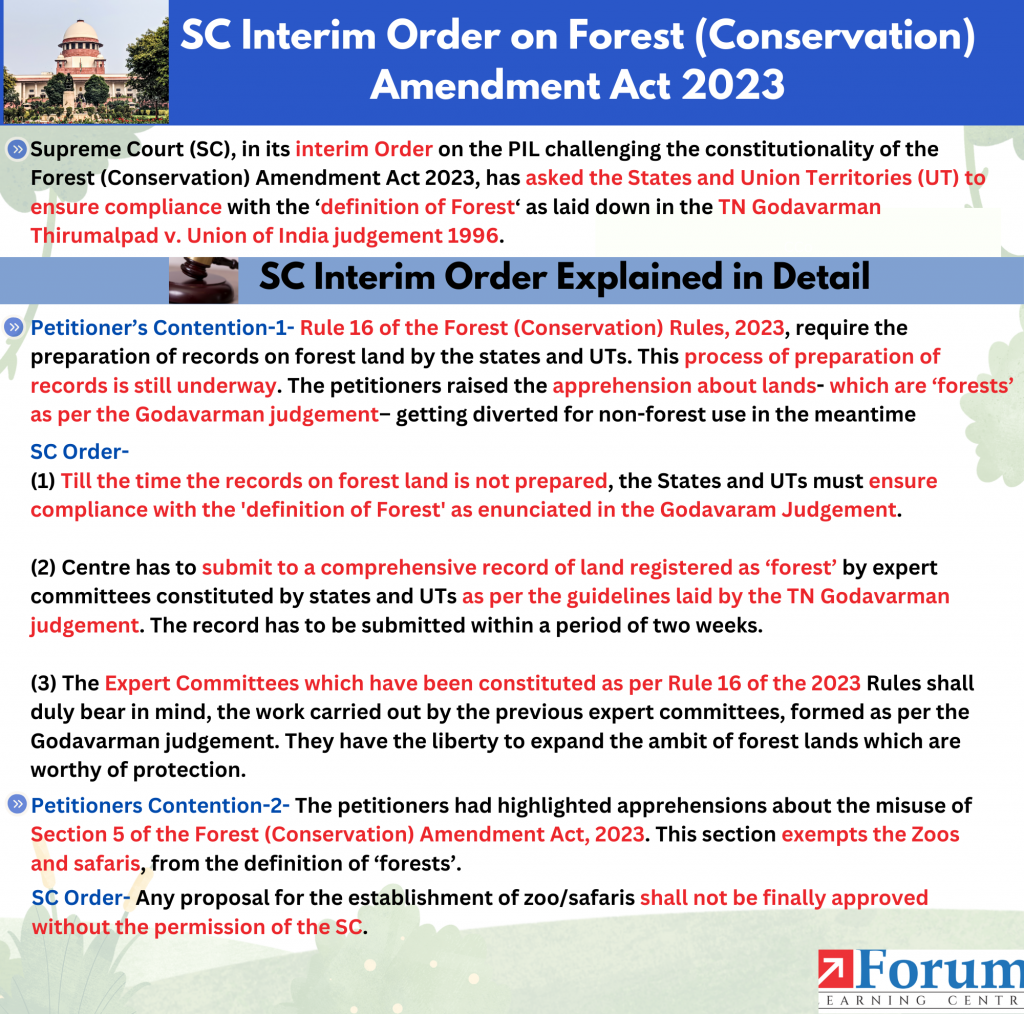Supreme Court (SC), in its interim Order on the PIL challenging the constitutionality of the Forest (Conservation) Amendment Act 2023, has asked the States and Union Territories (UT) to ensure compliance with the ‘definition of Forest‘ as laid down in the TN Godavarman Thirumalpad v. Union of India judgement 1996.
Rule 16 of the Forest (Conservation) Amendment Rules, 2023, mandates the states and UTs to prepare records on forest land, within a year from its notification. Till the time the records are not prepared, SC has directed the States and UTs to ensure compliance with the ‘definition of Forest’ as enunciated in the Godavaram Judgement.
| Note- According to the 1996 Godavarman Judgement– “forest” would include– (i) any land recorded as “forest” in government records; and (ii) any land that satisfied the dictionary definition of forest. (Oxford Dictionary defines forest as “a large area covered with trees and undergrowth”) |
What are the Petitioner’s contention and the SC interim order?
Petitioner’s Contention-1- Rule 16 of the Forest (Conservation) Rules, 2023, require the preparation of records on forest land by the states and UTs. This process of preparation of records is still underway. The petitioners raised the apprehension about lands- which are ‘forests’ as per the Godavarman judgement– getting diverted for non-forest use in the meantime.
SC Order-
(1) Till the time the records on forest land is not prepared, the States and UTs must ensure compliance with the ‘definition of Forest‘ as enunciated in the Godavaram Judgement.
(2) Centre has to submit to a comprehensive record of land registered as ‘forest’ by expert committees constituted by states and UTs as per the guidelines laid by the TN Godavarman judgement. The record has to be submitted within a period of two weeks.
Note- T.N. Godavarman Thirumulpad judgement brought in the concept of ‘deemed forests,’ or tracts. These tracts were not officially classified as such in government or revenue records. States were asked to constitute expert committees to identify such ‘deemed forests.’
(3) The Expert Committees which have been constituted as per Rule 16 of the 2023 Rules shall duly bear in mind, the work carried out by the previous expert committees, formed as per the Godavarman judgement. They have the liberty to expand the ambit of forest lands which are worthy of protection.
Petitioners Contention-2- The petitioners had highlighted apprehensions about Section 5 of the Forest (Conservation) Amendment Act, 2023. This section exempts the Zoos and safaris referred to in the Wild Life (Protection) Act, 1972, from the definition of ‘forests’.
SC Order- Any proposal for the establishment of zoo/safaris shall not be finally approved without the permission of the SC.
| Read More- States/UTs must adhere to the forest definition from the Godavarman judgment-SC |
What is the Forest (Conservation) Amendment Act 2023?
The Forest (Conservation) Amendment Act, 2023, amended the Forest (Conservation) Act, 1980. Its objective is to promote sustainable development while conserving India’s forests and biodiversity.
Land under the purview of the Act- The Act provides two types of land that will be under the purview of the Act-
(i) land notified as a forest under the Indian Forest Act, 1927 or under any other law,
(ii) land not covered in the first category but notified as a forest on or after October 25, 1980 in a government record.
Exempted categories of Forest land- Certain types of forest land are exempted from the provisions of the Act, such as:
(i) Forest land along a rail line or a public road maintained by the government providing access to a habitation, or to a rail, and roadside amenities up to a maximum size of 0.10 hectare.
(ii) Forest land situated within 100 km from international borders, Line of Control, or Line of Actual Control, for construction of a strategic linear project of national importance and concerning national security
(iii) Forest land, up to 10 hectares, for constructing security-related infrastructure.
(iv) Forest land proposed to be used for constructing defence related projects, camps for paramilitary forces, or public utility projects up to five hectares in a left-wing extremism affected area.
Permitted activities in forest land- The Amendment Act adds more activities to the list of permitted activities in forest land, such as:
(i) zoos and safaris under the Wild Life (Protection) Act, 1972
(ii) ecotourism facilities,
(iii) silvicultural operations and
(iv) any other purpose specified by the central government.
Power to issue directions- The amendment added that the central government may issue directions for the implementation of the Act to any authority/organization under or recognised by the centre, state, or union territory
| Read More- Amendment Act 2023- Provisions |
What was the Govt’s rationale for the Introduction of Forest (Conservation) Amendment Act 2023?
1. Clarity in Interpretation of Forest Land- With the SC judgement in Godavarman case, ambiguities arose in the applicability of FCA to lands that looked like forests, private forest lands, and plantations. The amendment makes the FCA applicable only to notified forests and lands that were identified as ‘forest’ in government records.
2. Fastening of Approval Process- The Forest Conservation Act,1980 required consent from numerous authorities at the state and national levels before engaging in any non-forest activity in an area designated as ‘forest.’ This approval process was very difficult and challenging.
3. Creation of additional carbon sink- There were concerns about the applicability of Forest Conservation Act 1980, on private plantations, after the expanded definition of forest in the Godavarman Case. This was impeding afforestation and tree plantation efforts outside official forest areas, and was an obstacle in the creation of additional carbon sinks.
4. Development of Security Infrastructure- The amendment will expedite the development of essential security infrastructure, particularly along international border areas like the Line of Actual Control (LAC) and Line of Control (LoC), as well as in notified Left-Wing Extremism regions.
5. Promotion of Agroforestry- The Amendment encourages private forests and agroforestry projects because these would not be considered forests under the FCA 1980.
6. Better forest management- The inclusion of additional activities in the forest land, such as creation of infrastructure for frontline forest staff, will facilitate a swift response to natural hazards in forested areas.
What are the Concerns with the Forest Conservation Amendment Act 2023?
1. Exclusion of Forest areas from the purview of the original Act- Section 1A inserted by the 2023 amendment has narrowed the expansive definition of ‘forest’ given in the Godavarman judgement. This amended FCA is only applicable to notified forest land and the land classified as forest as part of Govt record.
The Joint Parliamentary Committee (JPC) and the critics have pointed to the potential exclusion of 28% of India’s forests that lie outside Recorded Forest Areas from the purview of the amended FC Act.
2. Exclusion of fragile ecosystems which require protection- The Amended Act excludes some of India’s most delicate ecosystems, by exempting the requirement for forest clearances for security-related infrastructure within 100 km of international borders. These include globally recognized biodiversity hotspots such as the forests of northeastern India and high-altitude Himalayan forests and meadows.
3. Concerns about the exemptions granted in Forest Areas- The additional exemptions in the Amended FCA like construction of Zoo safaris and eco-tourism facilities, raise concerns about potential exploitation of forest resources without adequate environmental scrutiny.
4. Concerns regarding Centralization of Power- The Amended Act has raised serious concerns regarding the enhanced powers of the Central Govt in diversion of forest land for strategic purposes. States like Nagaland and Sikkim have expressed serious worries over the potential impact on their territories.
5. Disenfranchisement of local Forest Dwellers- The Amended Act has excluded certain forest areas and simplified the diversion process of forests for non-forestry use. This might lead to the disenfranchisement of local forest dwellers, who were provided consultation rights in case of any forest land diversion by the Forest Rights Act,2006.
What Should be the Way Forward?
1. Earliest completion of ground surveys by the expert committee- The expert committee constituted under Rule 16 of the Act must ensure to complete its report of recording the forest areas at the earliest.
2. Balance development and conservation- We must try to maintain a balance between development projects and forest conservation. Environment & social cost of Project should be in line with forest conservation.
3. Respecting the rights of Indigenous and forest community rights- The consent of local forest dwellers must be sought in case of diversion of forest land for non-forest purpose.
4. Specified Definition of Forest- A specified definition of forest must be made on the lines of Kyoto protocol definition of forests, which is currently being used for ISFR report.
| Read More- The Hindu, The Indian Express UPSC Syllabus- GS 3- Conservation, Environmental Pollution and Degradation, Environmental Impact Assessment |
Discover more from Free UPSC IAS Preparation Syllabus and Materials For Aspirants
Subscribe to get the latest posts sent to your email.








